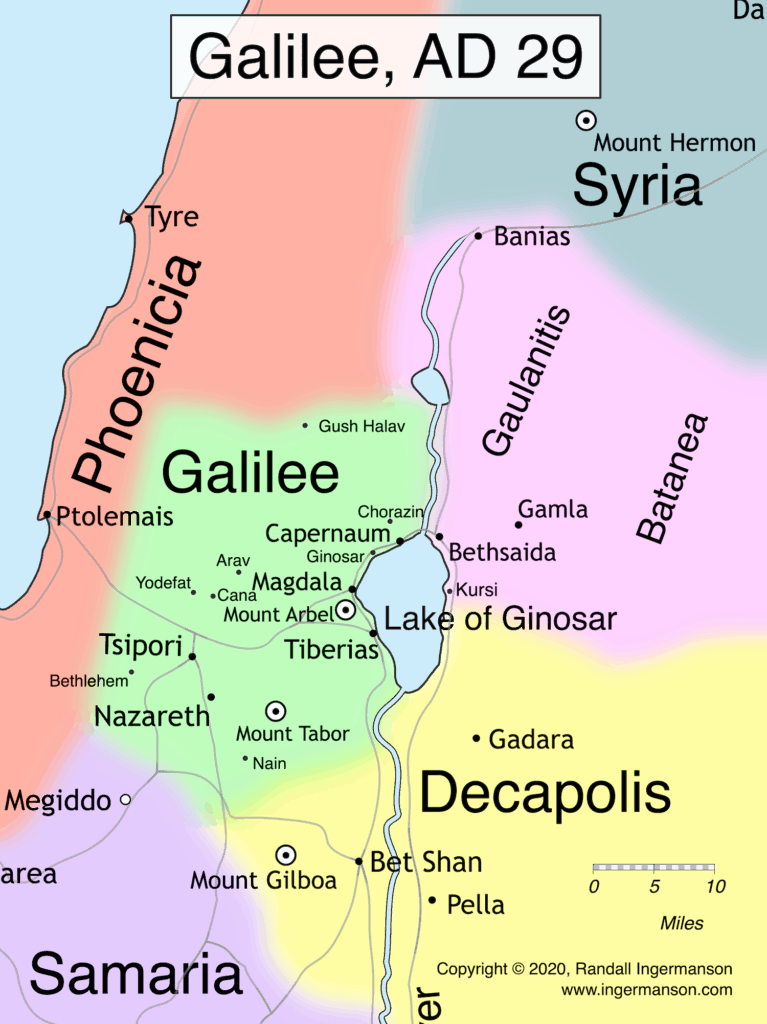It sounds absurd to ask what Jesus did on his summer vacation.
Except that we know exactly what he did on his summer vacation, because the gospels make that very clear.
Jesus Had a Day Job
Let’s start by noting the obvious fact that Jesus had a day job. He worked as a “tekton,” according to Mark 6:3. (This is the only verse in the Bible that says what Jesus did for a living.)
Note that “tekton” is a Greek word that means a manual laborer in stone, metal, or wood. This has been often translated into English as “carpenter,” but it’s not a great translation. From what I’ve been able to find, it seems that a better translation would be “builder.” Or “construction worker.”
Jesus’s father Joseph was also a “tekton,” according to Matthew 13:55. Without a doubt, Joseph taught Jesus and all his brothers the craft of the tekton, because that’s what a father did in those days.
Now Jesus had four brothers, according to the verses quoted above in Mark and in Matthew. Together with Jesus and his father, that made a total of six healthy men, all working the same job. Nazareth was a small village, and my best estimate for its size was about 200 souls. It seems likely that there wouldn’t have been enough construction work in Nazareth for the whole family.
Which means some of them often went out of town to find work. They didn’t have far to look. Tsipori, one of the two largest cities in Galilee, was only about three miles from Nazareth, and it had a lot of building activity during the first century. That’s a very plausible place where Jesus and his family could find day labor.
A day laborer could come into Tsipori, find a job for the day, and go home with a silver dinar—cash in hand. That silver dinar would feed twelve adults for a day, as we know from the Talmud.
So if all the men in the family of Jesus worked every day, they could theoretically have supported a family of 72 adults. That was far more cash than they needed.
Jesus Didn’t Work Every Day
We know Jesus didn’t work every day, because the gospels tell us that he and his whole family went to the various festivals in Jerusalem every year. See, for example, John 7:1-9. Those were big time commitments.
Passover, in the spring, lasted a full 8 days. Pentecost, in the early summer, lasted only 1 day. The long series of holidays in the fall began with the New Year, continued with the Day of Atonement, and finished with the feast of Tabernacles—more than 3 weeks.
And it took time to get to Jerusalem from Nazareth. Jerusalem is about 64 miles south of Nazareth as the crow flies. As the Galilean walks, it was probably closer to 75 miles. In theory, you could walk that in three very hard days, but four days would be much more doable, and five days would be a relaxed pace.
What this means is that Jesus and his family were gone from Nazareth at least two months out of every year, just to attend the feasts in Jerusalem.
They could afford this because they had a steady income of cash from their construction work. That was a luxury not every family in Galilee could afford. Had they been a family of farmers, some of them would have been forced to stay behind to care for their livestock and manage the farm.
But they were day laborers, able to work when they needed and take time off when they needed.
Jesus in Galilee
We know that sometime around the year Jesus turned 30 (plus or minus a couple of years), he began walking through Galilee preaching the good news that the kingdom of God was near.
There are some practical questions to ask:
- Why would anyone listen to a message like that? It sounds kind of weird.
- What did Jesus live on while he was doing this?
- It sounds impossible to walk all through Galilee. Why take on such a gigantic task?
All these questions have simple answers.
Why Would Anyone Listen?
The people of Galilee were heavily taxed by Herod Antipas, the ruler of Galilee, who was appointed by Caesar. Herod was not popular, and neither was Caesar. All of Galilee was looking for a better life. As they understood things, God would soon break in on their lives, raise up a new king—a son of David—who would toss out Caesar and Herod Antipas and all the rest and start over.
That would be the beginning of a new age, the Age to Come, in which the Son of David would rule over the kingdom of God. And that Son of David would be the anointed king of Israel, just like in the good old days. An anointed king was called in Hebrew a “mashiach.” In English, that’s usually transliterated as a “messiah.” In Greek, it’s translated as a “christ.”
News of the kingdom of God meant freedom to the oppressed people of Galilee. So if a man with a credible claim to be a Son of David came into a Galilean village, telling about a kingdom of God about to begin, the villagers would be only too happy to hear what he had to say. They weren’t thinking of a kingdom of God in the way a modern Christian might. They were thinking of a kingdom of God in the way a first-century Jew would naturally think of it—liberation from the hated Roman oppressors.
What Did Jesus Live on When He Was on the Road?
In first-century Galilee, villages had no entertainment except what they could create themselves. After the evening meal on summer nights, they’d gather in the village square to sing songs, tell stories, recite poems, study the Torah, make jokes. That was the normal entertainment.
But on a night when a visitor came to a village, he was the center of attention in the village square. A visitor was the only way to get news. So the whole village came to listen. And they all fought over who would get to offer the visitor hospitality.
Offering hospitality to strangers was a commandment, in the first place. But in the second place, it was the cool thing to do, because whoever had the visitor as guest would hear all the news first.
So Jesus had no problem finding a place to stay every night. He’d be housed and fed like royalty. And it no doubt helped that he had a reputation as a healer.
Jesus and his friends would have been able to find hospitality in any village of Galilee at no cost.
How Big of a Job Was it to Walk Through All Galilee?
Galilee was a region of about 750 square miles at the time of Jesus. (The region called Galilee today is quite a bit bigger that that.)

If you do the math, a circle with a radius of 15.45 miles has an area of 750 square miles. So any two points in Galilee were no more than about 30 to 35 miles apart. We also know that there were about 200 villages in Galilee, plus a few midsized towns and two large cities. I estimated the total population of Galilee in my blog post Around Galilee With Jesus at about 84,000 people.
In a region of 750 square miles, if there are 200 villages, that gives each village less than 4 square miles as its zone of influence. It works out that there must have been a village roughly every 2 miles or so.
If Jesus spent five months every summer going through Galilee, that would give him about 120 days per summer. Which means he could visit more than half the villages of Galilee in a summer. This would not be terribly hard. If villages were only a couple of miles apart, that’s not a big hike to move on each day to the next village.
No doubt he went back home many weekends to his headquarters at Capernaum. (Most of his men came from Capernaum, or thereabouts, and they had wives and children they wanted to see.)
Walking through Galilee is not a gigantic project. It’s very doable. If Jesus had three years to work his way through Galilee, there’s no doubt he could have hit every village at least once, and some of them more than once.
So that’s what Jesus did on his summer vacation. Don’t you wish you could have tagged along?
